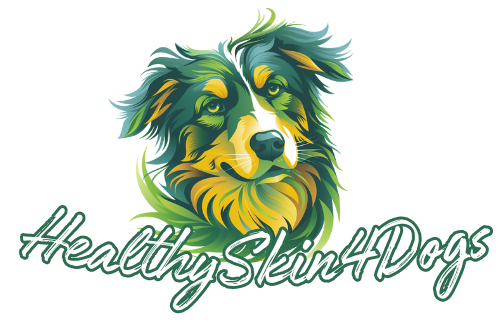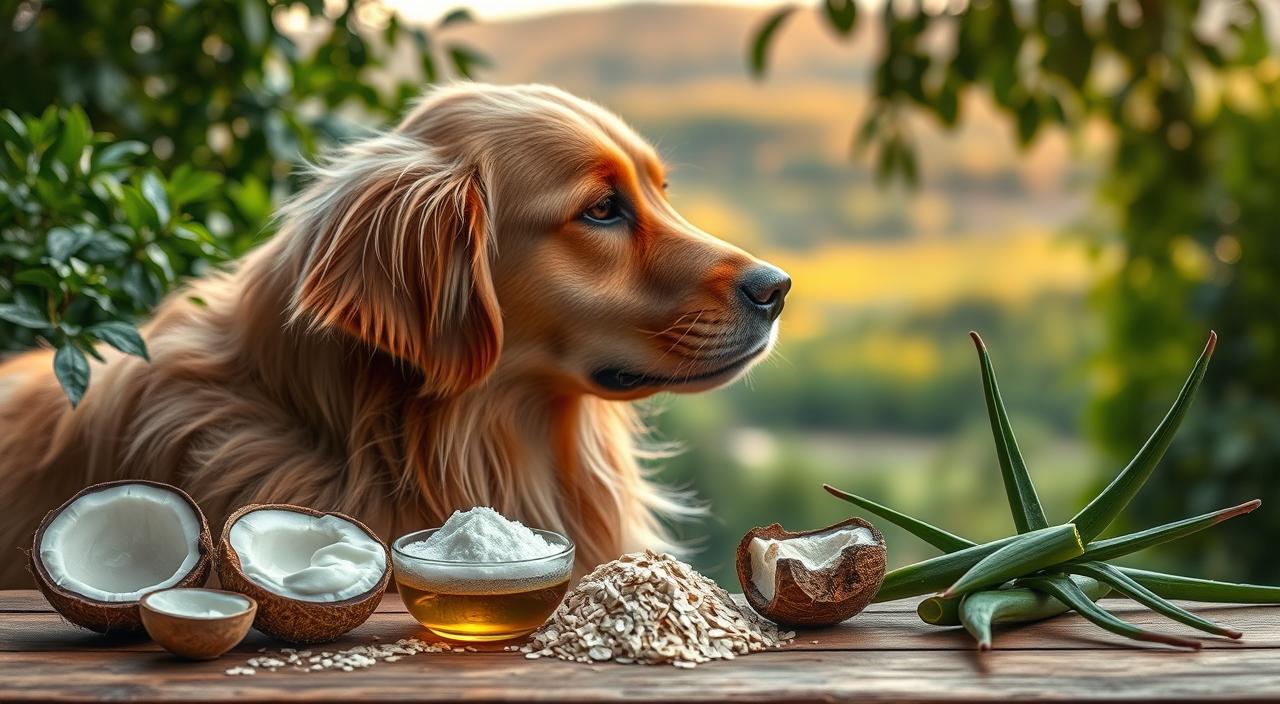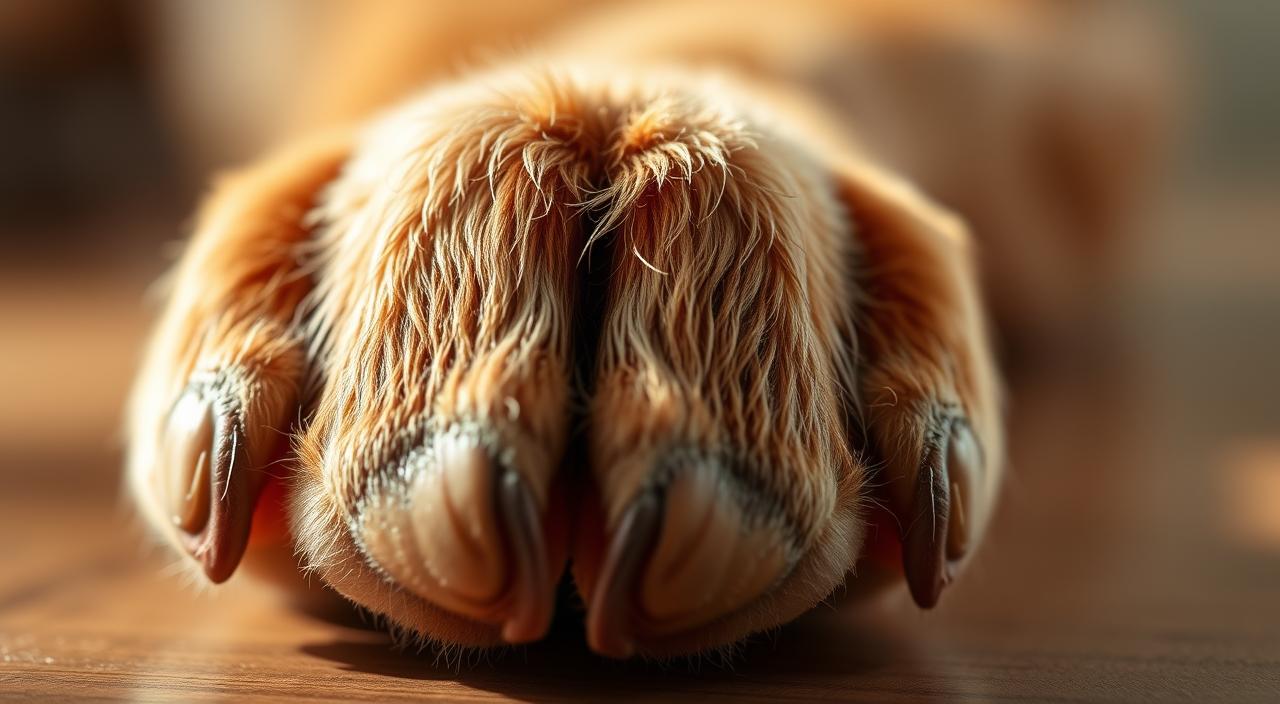You likely notice white flakes on the coat and bedding and want clear guidance on how to stop dog dandruff naturally—fast but gently. This short guide shows what those flakes mean, which simple steps help skin health, and when a vet visit is needed.
Dandruff means small skin flakes that shed from dry or oily skin. Often it signals diet, grooming, or environmental issues rather than a serious illness.
Most cases respond well to steady changes: better nutrition, essential fatty acids, soothing topical care, and smarter grooming. Left unaddressed, itching and irritation can worsen and lead to hair loss or secondary infections, so early observation matters.
Key Takeaways
- Flakes are a symptom—check diet, grooming, and environment first.
- Dandruff can come from dry or oily skin; do not assume one cause.
- Start with gentle measures: balanced food, omega fats, and mild topical care.
- Monitor itch, flake amount, and coat shine weekly for progress.
- See a veterinarian if irritation, hair loss, or infection signs appear.
Seeing flakes on your dog’s coat? Here’s what that really means
Seeing flakes fall from a furry companion can feel worrying, but most cases point to treatable skin issues rather than serious illness. Flakes are simply shed skin cells that show up more on dark fur and bedding. They become obvious after brushing or when the coat traps loose material.
Often dandruff reflects an imbalance in oil production, bathing frequency, or indoor dryness. Other visible clues include a dull or greasy coat, mild redness, or extra itch after weather shifts or grooming. Frequent scratching can break the skin barrier and raise the risk of bacterial or yeast infections.
- Check bedding and favorite spots for flake buildup — that gauges scope.
- Run quick self-checks: new shampoo, heating season, or a new food may trigger sensitivity.
- Track patterns for a week: do flakes worsen after baths or improve with brushing?
| Finding | Mild | Persistent / Red flag |
|---|---|---|
| Flake amount | Scattered, occasional | Heavy, spreading |
| Other symptoms | Minor itch, slight dullness | Severe itch, odor, hair loss |
| Next step | Adjust grooming, monitor | Consult veterinarian |
Spot the signs of dandruff and irritated dog skin
Noticing flaky fur, scabs, or an odd smell signals that a pet’s skin may be irritated. Owners can watch for simple clues each day that point toward mild or more serious symptoms.
Visible clues include fine white flakes on the coat, a dull or greasy appearance, scattered redness, and small scabs. Less obvious signs are pimples, bumps, or inflammation around hair follicles. Odor can come from yeast or bacterial overgrowth.
Behavioral cues are often the first hint: frequent scratching, chewing at paws or tail base, excessive licking, and restlessness when settling. Repeated rubbing can cause hair thinning or patchy hair loss in focused spots.
- Oily skin can still shed flakes — oiliness and flaking may occur together.
- Persistent irritation and discomfort mean owners should act early with gentle care.
- Photograph problem areas weekly to track progress objectively.
- Note recent changes: new foods, treats, shampoos, or seasonal shifts that began when symptoms first appeared.
| Sign | What to look for | Urgency |
|---|---|---|
| Flakes | Scattered white pieces after brushing | Monitor; improve grooming and diet |
| Behavior | Scratching, licking, chewing, restlessness | Act soon if frequent or worsening |
| Sores & odor | Scabs, pimples, foul smell, hair loss | Seek veterinary advice promptly |
What’s driving the flakes: common causes and conditions
Identifying why a pet sheds skin is the first step toward calmer, healthier fur and less mess at home.
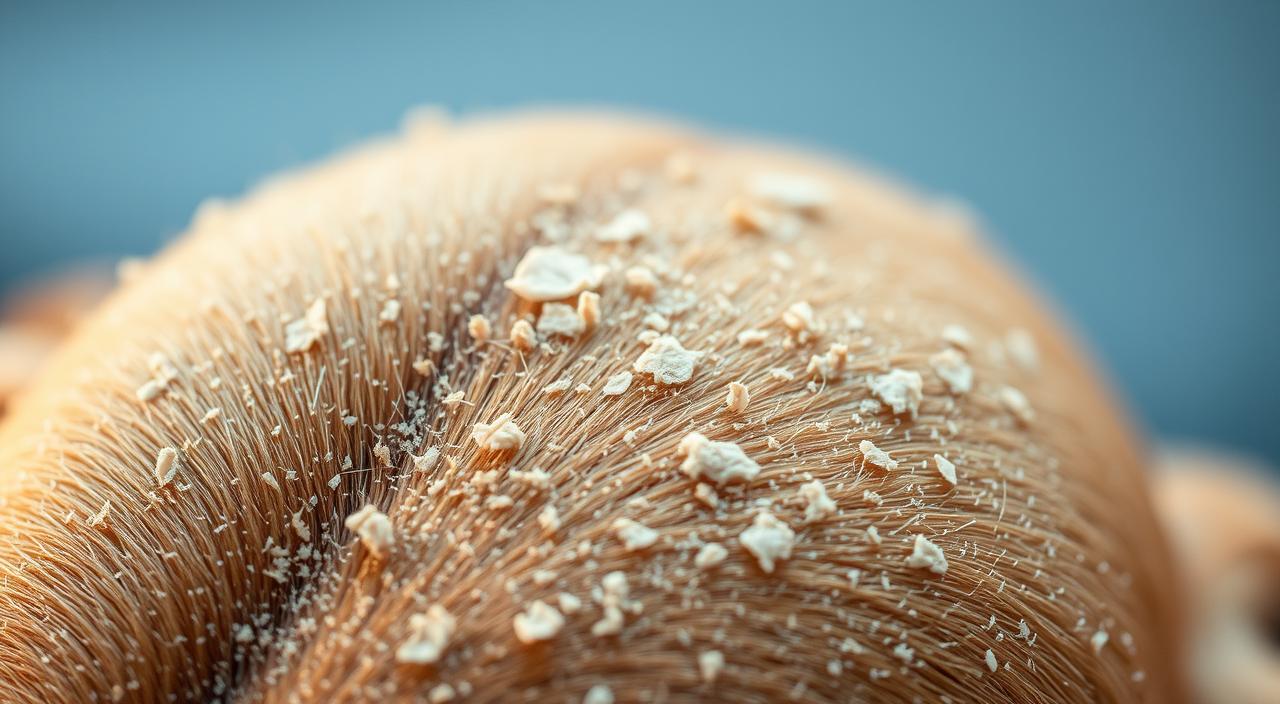
Dry versus oily presentations
Dry skin often shows fine, powdery flakes and tight, itchy patches. Oily seborrhea produces greasy scales, a musty odor, and thicker flakes.
Allergies and contact irritation
Food proteins (beef, chicken, dairy, wheat, soy) or pollens and dust can inflame skin and trigger itch and flakes. Owners should review diet and recent product changes.
Parasites and mites
Cheyletiella mites — called “walking flakes” — resemble dandruff but move. A vet can confirm with microscopy or skin scrapings.
- Skin infections: yeast and bacteria thrive on damaged areas, adding redness and odor.
- Hormonal issues: hypothyroid and Cushing’s may thin hair and drive chronic flaking.
- Grooming and environment: harsh shampoos, overbathing, or dry indoor air strip oils and worsen dry skin.
| Cause | Key sign | Next step |
|---|---|---|
| Dry skin | Fine flakes, tight coat | Humectant care, adjust baths |
| Seborrhea | Greasy flakes, odor | Vet assessment, medicated therapy |
| Parasites | Itch, moving flakes | Microscopy by vet |
If flakes increase, itching is severe, or there’s odor, consult a vet for diagnosis and quicker relief.
How to stop dog dandruff naturally
Nutrition is the easiest, most effective step owners can take to reduce visible flakes and itchy skin. A focused meal plan supports the skin barrier and improves coat feel over weeks.
Start with a balanced diet that supports skin coat health
Feed whole-food choices when possible: varied animal proteins, organs, vegetables, and a little fruit. High‑quality protein supplies amino acids for keratin, which builds a strong skin coat.
Boost essential fatty acids for anti-inflammatory support
Increase Omega-3s from salmon, mackerel, sardines, chia, or a vet‑formulated fish oil. These fatty acids calm inflammation and help reduce flakes.
Avoid common allergens and processed foods
Limit beef, chicken, dairy, wheat, and soy if reactions appear. Cut ultra‑processed kibbles and treats that are high in pro‑inflammatory oils.
Add targeted supplements and hydrate well
- Consider biotin, zinc, and vitamin E for skin repair and antioxidant support.
- Probiotics help the gut-skin axis and overall skin health.
- Serve fresh water, and mix unsalted bone broth or extra water into meals to boost moisture.
Track changes for 4–8 weeks. Combine diet shifts with gentle grooming and environmental tweaks for faster, lasting improvement in dogs with flakes.
Natural at-home relief your dog can feel right away
A few targeted, low-risk remedies bring quick comfort for itchy skin and visible flakes. Use these methods gently and introduce one at a time so reactions are easy to spot.
Coconut oil: topical hydration and supportive fatty acids
Apply a thin layer of coconut oil on dry patches to lock in moisture and offer mild antibacterial support. Let the oil absorb before the pet lies on bedding.
Small amounts ingested by licking are generally safe, but use sparingly—fatty oils add calories and may upset sensitive stomachs.
DIY oatmeal bath to calm itchy, dry skin
Grind 1/3–1 cup oats into a fine powder and stir into lukewarm water until milky. Add a cup of milk or 1 tbsp olive oil if desired.
Soak the coat 5–10 minutes, rinse well, and pat dry. Short baths protect natural oils and ease inflammation from dry skin.
Chamomile or green tea soak to soothe irritation
Brew and cool several tea bags, then press cooled bags on local spots or steep multiple bags in a warm bath for full-body relief. Tea offers gentle anti-inflammatory benefits.
Apple cider vinegar: targeted use with hot-spot caution
Mix ACV 50/50 with water and spray only on intact skin to help balance surface flora. Never apply on open sores or raw areas—these require veterinary care.
Use a humidifier to add moisture back into dry indoor air
Place a humidifier near the pet’s resting area during heating or AC seasons. Restoring room humidity often cuts flake formation and eases dry skin without extra products.
- Limit water temperature to lukewarm; hot water worsens dryness.
- Keep soaks short (5–10 minutes), rinse fully, and pat dry to avoid residue.
- If irritation worsens or sores appear, stop remedies and seek veterinary advice—infected areas need professional care.
- For related skin issues like yeast overgrowth, consider this practical yeast infection home remedy as a reference.
| Remedy | Use | Precaution |
|---|---|---|
| Coconut oil | Moisturize small patches | Use sparingly; avoid overweight dogs |
| Oatmeal bath | Soothe whole coat | Rinse well; lukewarm water only |
| ACV spray | Balance surface flora | Do not apply to open skin |
Choosing the right dog shampoo and ingredients that help
A focused shampoo choice protects the skin barrier and helps manage scale without harsh chemicals. Look for gentle, natural ingredients that soothe irritation and support moisture.
What to look for
Choose dog-formulated products containing colloidal oatmeal, aloe vera, calendula, and chamomile. These calm inflammation and ease itch.
Include formulas enriched with coconut oil and essential fatty acids for hydration and softer fur between baths.
What to avoid
- Avoid human medicated shampoos: they change pH and can worsen dry skin and flakes.
- Steer clear of sulfates, parabens, and artificial fragrance—these irritate sensitive skin.
- Test new products on a small patch and watch for redness or added scratching.
| Category | Good | Bad |
|---|---|---|
| Soothing agents | Oatmeal, chamomile, calendula | Synthetic fragrances |
| Moisture support | Aloe, coconut, fatty acids | Sulfates (strip oils) |
| Formulation | Dog pH‑balanced shampoo | Human dandruff shampoos |
Bathe with lukewarm water and rinse thoroughly. Space baths so oils remain intact. Gently towel-dry and let air finish drying before brushing. These steps help dogs keep healthier skin and fewer flakes.
Build a gentle grooming routine that deflakes without over-drying
A calm, steady grooming plan reduces visible flakes while protecting the skin barrier and coat shine. Consistency matters: small actions repeated over time bring measurable improvements.
Regular brushing distributes natural oils and lifts flakes
Brush several times per week with a soft brush or grooming mitt. This lifts loose flakes and spreads natural oils across the coat.
- Use a soft tool for sensitive areas and a slicker or comb for long or double coats.
- Detangle gently before bathing to prevent matting and trapped debris near the skin.
- Finish with a light brush after drying to redistribute oils and smooth the coat.
Bath cadence and lukewarm rinsing protect healthy skin
Keep baths brief and use lukewarm water. Hot water and harsh shampoos strip oils and worsen dry skin.
- Rinse thoroughly to remove all suds; residue can itch and attract flaking.
- Set a bathing cadence—many pets do well every 3–4 weeks unless a vet recommends more often.
- Towel-dry with gentle pressure; avoid vigorous rubbing that irritates fragile patches.
| Grooming step | Purpose | Quick tip |
|---|---|---|
| Brushing | Lift flakes, spread oils | Soft brush for face and belly |
| Detangling | Prevent mats that trap debris | Work in sections, be patient |
| Bathing | Clean without stripping oils | Lukewarm water, full rinse |
Monitor the routine over several weeks. If the skin becomes tight, itchy, or flakes increase, adjust frequency and consult a veterinarian for targeted care.
Hydration, environment, and exercise: small daily habits that protect skin health
Daily habits can make a clear difference for a dog’s skin and coat. Small, steady changes at home reduce flaking and support long-term comfort.
Keep fresh water available and add moisture in meals
Always provide clean, filtered water and refill bowls often. Mild dehydration shows up quickly in the skin coat and in coat shine.
Hydrate dry kibble with water or unsalted broth, or add wet food on occasion. This helps dogs with dry skin, especially during heating months.
Adjust indoor humidity and temperature seasonally
Use a humidifier near sleeping areas during cold, dry months to ease skin tightness. Avoid excess humidity: too much moisture can encourage yeast and odor.
Keep moving for better circulation and overall health
Regular walks and play improve circulation, which helps nutrient delivery to the skin and supports coat health. Short, daily activity sessions offer steady benefit over time.
| Habit | Benefit | Quick tip |
|---|---|---|
| Fresh water | Hydration for skin | Clean bowl twice daily |
| Meal moisture | Improves skin suppleness | Add warm broth or water |
| Indoor humidity | Reduces dry skin | Use a humidifier; avoid over-humid rooms |
When to see the vet for persistent dandruff or skin infections
Persistent scaling, strong odor, or sudden hair loss are signs that professional diagnosis is needed. If flakes spread quickly or sores appear, prompt vet care reduces risk of secondary infections and discomfort.
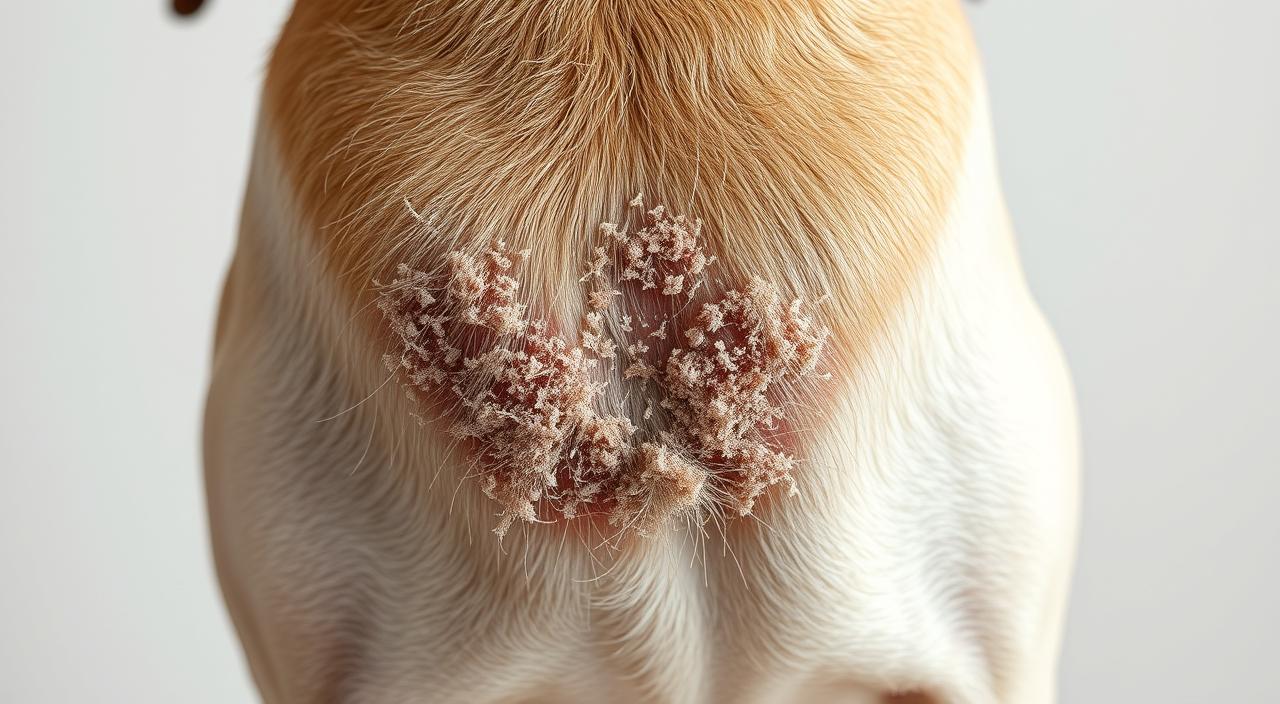
Red flags to act on
Seek a vet promptly for open sores, escalating hair loss, severe itch, foul odor, or rapidly spreading flakes. These signs often mean a bacterial or yeast infection or another underlying condition.
Diagnostics you can expect
Clinics perform a physical exam and review diet and environment. Common tests include skin scrapings to rule out mites, cytology for microbes, and allergy workups if signs recur seasonally.
When medicated shampoo or other treatment is needed
Persistent dandruff from infections or seborrhea may require medicated shampoo (ketoconazole, salicylic acid) or topical and oral treatment. Follow contact times and dosing exactly—these products work when used as directed.
| Clinic step | Why | Expected outcome |
|---|---|---|
| History & exam | Find triggers and pattern | Tailored plan for skin care |
| Skin scrapings/cytology | Detect mites, yeast, bacteria | Targeted antimicrobial treatment |
| Allergy testing | Identify food or environmental causes | Diet or environment changes |
| Medicated shampoo/treatment | Control scaling and microbes | Reduced flakes and improved coat |
Conclusion
Simple, steady care often brings visible improvement in a few weeks. Prioritize a balanced diet and targeted fatty nutrients to rebuild the skin barrier and support overall health.
Use soothing home measures: oatmeal soaks, gentle shampoos, and a humidifier can ease itch and reduce flakes. Keep routines gentle—brush regularly, bathe with lukewarm water, and avoid harsh products that strip oils.
Monitor progress over time and adjust what helps your dog skin coat. Involve a veterinarian when red flags or persistent issues appear. Small, consistent steps protect coat health and yield calmer, softer fur as results emerge.
